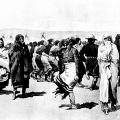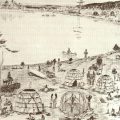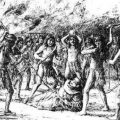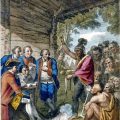
In 1889, a Paiute prophet known as Wovoka in Nevada died during an eclipse and then returned to life with a message and dance for his people. The word of Wovoka’s vision quickly spread to other tribes and the religious movement known as the Ghost Dance began.
In 1890, Sitting Bull, a Northern Arapaho spiritual leader from the Wind River Reservation in Wyoming, brought the Ghost Dance to the tribes in Oklahoma, including the Comanche.
One of the visitors at an 1891 Comanche Ghost Dance in Oklahoma was Frank White. He sat on the north side of the dance area and ate a lot of peyote. When the Comanche asked him who he was, he said that he was Pawnee. Following the Comanche Ghost Dance, he attended a Ghost Dance among the Wichita. There he once again ate peyote, he watched the dance, and then he joined it.
While dancing, Frank White went into a trance where he saw the stream, the tree, the Messiah, and the village of the people. He saw the people dance, and in his trance he joined them and from them he learned Ghost Dance songs in Pawnee. The English words to the first song he learned are:
The place whence you come,
Now I am longing for.
The place whence you come,
Now I am ever mindful of.
When he woke from the trance he told the people what he had seen. In this way, Frank White became a prophet and the people felt that he had the same power as Sitting Bull, the Arapaho Ghost Dance leader.
When he returned home to the Pawnee he began to teach the doctrine and the songs of the Ghost Dance to the southern bands. He told the people:
“The kingdom is coming soon now, so the people must prepare. This that I have is called ghost dancing. You must stop working because when the kingdom comes you won’t take plows or things like that along. That’s not ours.”
The version of the Ghost Dance that Frank White gave to the Pawnees was not the same one Sitting Bull had given to the Caddos. In addition, the dance had a different focus than Ghost Dance advocated by the Paiute prophet Wovoka.
While White saw himself as a prophet as a new religious movement, he was also respectful of Pawnee culture. He met with the elders and discussed his vision. The elders accepted his vision and were satisfied with him in the role of Ghost Dance prophet.
Frank White, who was of the Kitkahaxki band, began holding regular Ghost Dances and members of the Skiri band were attending. At first, the songs included Arapaho and Wichita songs as well as the Pawnee songs he had learned in his trance. During the dances, people would have visions which explained other ceremonies which they should be doing. In this way, the Ghost Dance began to grow among the Pawnee.
The Ghost Dance doctrine among the Pawnee held that the dead could communicate with the living through the visions brought about during the dance. Hundreds of Pawnee gathered to dance the new dance so that they could see their deceased loved ones. Anthropologist Alice Beck Kehoe, in her book The Ghost Dance: Ethnohistory and Revitalization, reports:
“Then a truly marvelous thing happened: In the visions, people saw not only relatives but also the dead doctors and priests. These leaders instructed the visionaries in the performances of the rituals and healing arts and advised them to carry out the practices as best they could under the reservation circumstances.”
In addition to face painting, the Pawnee Ghost Dance included the use of feathers as hair ornaments. In the trance visions, people usually found themselves associated with either the eagle or the crow and thereafter they wore feathers to symbolize this vision.
At the beginning of each dance a woman would be chosen to bless the dance grounds. She would be seated at the door of White’s tipi with her face painted. For this one day she was holy. At the end of each day of dancing, the dancers moved to the center of the circle and then back out slowly shaking their blankets and shawls. In this way they cast off the burdens of the day.
The United States government became concerned about the growing popularity of the Ghost Dance movement and in 1891 the Indian agent wrote to Frank White and ordered him to cease holding Ghost Dances. In addition, White was ordered to return to the Kiowa or Wichita agency. In an article in Chronicles of Oklahoma, Todd Leahy reports:
“White, however, chose not to leave his people or abandon the Ghost Dance. Moreover, he moved to widen the ceremony’s body of adherents, and in late December 1891 Delawares, Otoes, and Osages attended dances on the Pawnee reservation.”
In 1892 the government realized that the Pawnee were still doing the Ghost Dance and set out to stop it. The Indian agency clerk met with Frank White and told him that he was an impostor and that he was to leave the reservation and never return. The following morning, over 200 Pawnee, painted with Ghost Dance colors, surrounded the agency and demanded a council. The agent told them that they were following a false Messiah and that the Ghost Dance would not be tolerated. In the words of the agent:
“I plainly told them that the dance could not be tolerated and would not be; that this government would last and assert her power, and that they should be obedient to the law and be good Indians, return to their homes and cultivate their farms and raise something to eat.”
Following the meeting, the Pawnee continued to gather in secret in order to Ghost Dance.
Fearing that the Ghost Dance would interfere with the government’s plan to break up the reservations into allotments, Frank White was arrested remanded to jail. The Pawnee decided to fight to get their prophet back and a party of armed warriors gathered at the railroad station to take him from the marshal. However, the agent sent a telegram and when the train arrived it was filled with soldiers. The Pawnee decide that there were too many soldiers and so the marshal left with White.
While Frank White was away, many Pawnee were persuaded to choose allotments. According to anthropologist Alexander Lesser, in his book The Pawnee Ghost Dance Hand Game: Ghost Dance Revival and Ethnic Identity:
“It must be remembered that in dividing up their land, and selling a good part of it, the Pawnee were doing something which was opposed to the faith and doctrine of the Ghost Dance.”
After several days in jail a writ of habeas corpus was issued. The judge gave White a lecture on the dangers of indulging in the Ghost Dance. He was then released and returned to the reservation.
While Frank White was in jail, William Hunt emerged as a new Ghost Dance leader. Hunt drastically altered the Ghost Dance. Rather than dancing, Hunt offered a doctrine that included the laying on of hands. White was angered by the new development and demanded that Hunt be arrested and deported for practicing the Ghost Dance. The agent ignored the demand feeling that it was to his advantage to let the Ghost Dance leaders quarrel among themselves.
Among the Pawnee, Frank White was considered to be the sole authentic prophet of the Ghost Dance and its doctrine. Those who had visions reported them to him. White granted permission to use the vision, to wear feathers, to paint the face, and to put on a dance. For conferring these rights, White was usually given gifts.
Frank White did not live up to the ideals of conduct for a spiritual leader among the Pawnee. He used peyote – which the Pawnee felt made him wise – but he drank whiskey at the same time. According to one of his contemporaries:
“Whiskey and peyote do not mix, they cannot go together. That’s what killed him.”
He died in 1893, but the Ghost Dance that he brought to the Pawnee continued to live.




Leave a Reply